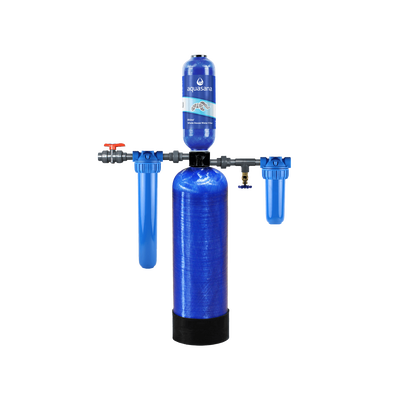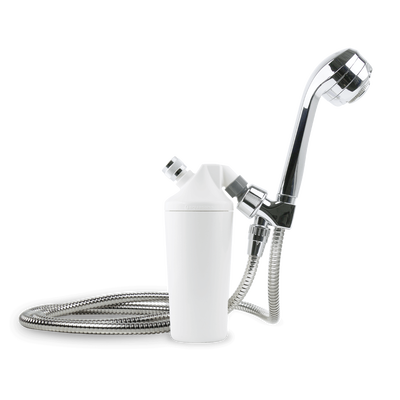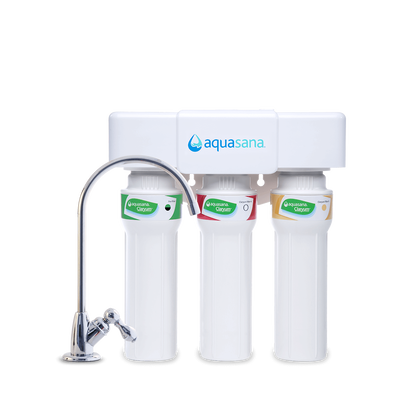2024 marks the 6th installment of the annual Aquasana Water Quality Survey, and the most notable finding from this year’s data reveals how closely Americans associate filtering their drinking water with overall longevity. In fact, 76% of Americans believe drinking clean, filtered water aids in living a longer and healthier life. Additionally, more than three-quarters (77%) of U.S. adults agree that access to clean, trustworthy tap water at home is important for their health.
In this post, we’ll explore new trends we’ve uncovered such as the role hydration plays in longevity, along with long-term trends we’ve been tracking over the past six years. Read on to discover our top insights from our April 2024 survey of 1,093 U.S. adults (ages 18+).
Optimal hydration is an essential part of longevity
It’s well understood that hydration is important for health, but a National Institutes of Health study from 2022 uncovered new findings — that people who stay well-hydrated develop fewer chronic conditions and live longer than those who do not hydrate properly. Furthermore, the study suggests that staying well-hydrated is crucial for slowing down the aging process. Meanwhile, those who don’t hydrate properly are more likely to show biological signs of faster aging — meaning their body appears older than it actually is. Dehydrated individuals also had a higher chance of dying prematurely compared to their well-hydrated counterparts.
Our survey revealed Americans believe hydration is vital for their health, and these National Institutes of Health findings support that belief. In our survey, we asked people to identify the top three lifestyle choices they think are most important to living a longer and healthier life. Hydration took the number three spot for most important lifestyle choice, following diet and nutrition, and adequate sleep.

Of course, drinking enough water is only part of the equation for achieving proper hydration and longevity. The quality of the water you drink is crucial for overall health and well-being since exposure to potential contaminants in unfiltered tap water poses a greater risk of illness from waterborne diseases as well as various short- and long-term health effects.
Americans may be more hesitant to trust tap water after years of increasing news headlines detailing contamination events across the country including lead, PFOA/PFOS, microplastics, and more. A U.S. Geological Survey from earlier this year found nearly half the tap water in the U.S. is contaminated with PFAS, also known as “forever chemicals,” which linger in the human body and have been linked to cancer, thyroid disease, liver damage, decreased fertility, and other health issues. We’ve also seen reports of public schools across the country that are “plagued by high lead levels in drinking water” — and lead contamination is such an issue that the Biden-Harris administration recently committed $3 billion to the EPA to replace lead service lines across the nation.
While these events may lead some people to lean on bottled water as a safer alternative, we now know that bottled water may pose a higher risk of contamination due to fewer regulations. Additionally, bottled water poses a higher risk of microplastic contamination. Microplastics are tiny plastic particles less than 5 mm in length that slough off plastic as it degrades and cannot decompose. Microplastics may be invisible to the naked eye, but a State University of New York study found they were present in 93% of water bottles. Additionally, one study found bottles have twice as many microplastic particles as tap water. The effects of microplastic exposure are just starting to be studied, but early research suggests they can increase the risk of heart attack and cardiovascular disease.
To ensure access to cleaner, safer drinking water for optimal hydration, we recommend using a water filter over bottled water or drinking unfiltered water straight from the tap. Water filtration systems provide an extra layer of protection against contaminants in your home. More importantly, you can choose a filter that will address the specific contaminants of concern in your area, which can be found in your local Water Quality Report.
Given the vital role hydration plays in overall health, it makes sense that quality is just as important, if not more, than quantity. In the following section, we’ll discuss Americans’ top drinking water contaminants of concern and how they’ve shifted over time.
What contaminants concern people the most in 2024 and how has this changed over time?
In 2024, lead was the number-one contaminant of concern in America. Nearly one quarter (24%) of survey respondents selected it as their top contaminant concern, up 50% year-over-year (YoY) from just 16% in 2023. Although lead has historically remained near the top of the list, it’s possible that the resurgence of widespread news coverage about lead contamination across the U.S. helped put the toxic metal back in the top spot.
Behind lead — bacteria, cysts & viruses came in a close second on the list (23%). This group has consistently been in the top three contaminants of concern since 2020 but saw a notable spike in 2024, up 64% YoY from 2023 — when it tied with PFOA/PFOS and pesticides & herbicides for third place.
After the top two contaminants of concern, we saw a stark drop-off in concern, with no other contaminant accounting for more than 10% of the vote:

Microplastics
We briefly touched on microplastics earlier, noting that they’re tiny plastic particles from waste that are invisible to the naked eye and can linger in the human body and environment. Researchers are still learning more about the contaminant, but the sheer omnipresence of microplastics that have been discovered in today’s environment is shocking. One study found that people inhale or ingest an average of 74,000 to 121,000 microplastic particles each year through breathing, eating, and drinking. To contextualize this, that’s the equivalent of eating a credit card every week. Furthermore, a landmark study from earlier this year found tiny shards of plastic inside more than 50% of fatty deposits from clogged arteries — linking microplastics to a variety of severe health problems.
This year’s survey data revealed a significant increase in the percentage of Americans who selected microplastics as their top contaminant concern (9%), up 350% YoY from 2% in 2023. In line, the survey also found that 83% of U.S. adults are concerned about microplastics being in their drinking water.

PFAS
Another contaminant that’s frequently in national news headlines is PFAS, and our survey found that concern among Americans is significantly on the rise. Also known as “forever chemicals”, they are a category of nearly 15,000 synthetic chemicals that are nearly indestructible and have a long list of health risks.

PFAS is commonly used in a variety of household goods like nonstick cookware, cleaning products, water-resistant fabrics, personal care products, fast food containers, stain-resistant coatings, and firefighting foam. In addition to contamination from industrial and sewage treatment sites, PFAS enters drinking water supplies and sources when these products are discarded in landfills, where it can leach into groundwater and lead to health issues like cancer, decreased fertility, thyroid disease, and liver damage among other concerns. Scientists are still learning about PFAS, and there’s a lot that’s still unknown about the toxic chemicals and the true danger they present.
Although PFAS tied for third place amongst other contaminants in this year’s survey, concern over toxic forever chemicals in drinking water has risen significantly over the past few years – spiking +233% from just 3% of U.S. adults in 2020 to 10% in 2024. In fact, concern over PFAS has risen the highest of any contaminant we’ve tracked since 2020 (excluding microplastics, which we only started tracking in 2023). On a broader scale, the vast majority of Americans (80%) reported being at least somewhat concerned about the presence of PFAS in their homes.
In your journey to live a long and healthy life, it’s essential to hydrate with drinking water that’s cleaner and safer with reduced contaminants. In the following section, we’ll share insights about Americans’ views on the trustworthy sources of drinking water.
Americans are more likely to rank a filtered water source as the most trustworthy source of drinking water in 2024
According to this year’s survey, a growing number of Americans believe filtered water is the most trustworthy source of clean drinking water, ahead of bottled water and unfiltered drinking water from the tap.
In fact, 56% of people surveyed indicated filtered water as the most trustworthy source of clean drinking water — up 14% from 49% in 2023. In comparison, public trust in unfiltered tap water has declined significantly. Just 8% of Americans selected it as the most trustworthy drinking source in 2024, a dramatic 74% drop YoY from 31% in 2023.

Of course, it’s important to understand that not all water filters are equally effective. When choosing a water filter, we recommend starting by looking at your local Water Quality Report to find out which contaminants are in your tap water. If you rely on well water, you’ll want to do a private test.
Once you know the contaminants in your water, use it as a checklist and look for a filter that has been independently tested and certified to tackle each of them. However, be cautious of any marketing claims you come across. A water filter may claim “This filter addresses lead!” But without a performance data sheet, you won’t know if it actually reduces 95% of lead or only 1%. Even if a performance data sheet is provided, pay special attention to which organization conducted the testing. Verify the filter was tested by an independent third-party like the WQA or IAPMO and certified to NSF Standards.
Conclusion
One of the largest new takeaways to come out of the sixth annual Aquasana Water Quality Survey is the strong connection the vast majority of Americans make between filtered drinking water and longevity.
We found that 76% believe drinking clean, filtered water aids in living a longer and healthier life. Hydration is clearly top of mind for Americans, and the quality of the water they’re drinking is just as important, if not more, than the quantity.
Tap and bottled water pose risks from contaminants like PFAS, lead, and microplastics — so it’s imperative to use a water filter as an extra layer of protection. By filtering your tap water at home, you can also target specific contaminants present in your drinking water or impurities you may be concerned about — which seem to shift each year based on recent events and new findings. Overall, the vast majority of Americans acknowledge that using a filter is a good idea, given our survey found it’s the most trustworthy source of clean drinking water.
Just be sure to check the performance data sheet of any system you’re considering, as you’ll want to verify it has been tested and certified by an independent third-party to ensure the filter is actually effective in addressing your specific contaminants of concern. If you’re looking for a filter you can trust, Aquasana offers a wide range of systems including countertop, under sink, shower and whole house filters. Each has been independently tested and certified to various NSF Standards and have detailed performance data sheets you can review prior to purchasing so you can feel confident in your decision.
Survey Methodology
The findings presented in this article are the result of an April 2024 study of 1,093 U.S. adults, conducted by Aquasana. (Confidence Level: 95%, Margin of Error: 3%)


